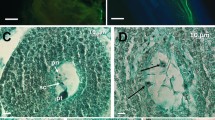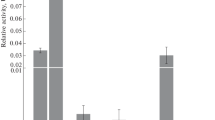Summary
An attempt has been made to construct a genetic bridge between the cultivated tomato, Lycopersicon esculentum and its wild relatives L. peruvianum and L. chilense. A complex interspecific hybrid genotype SB 2 has been assembled which shows strong sexual compatibility with both L. esculentum and L. chilense, and a rather weaker degree of compatibility with one specific race of L. peruvianum. The crossing relations of a hybrid between SB 2 and L. peruvianum have also been investigated. This hybrid retains a high level of sexual compatibility with L. esculentum and only shows a slight increase in its ability to set seed on the L. peruvianum parent.
Similar content being viewed by others
Literature
Alexander, L.J. (1963): Transfer of a dominant type of resistance to the four known Ohio pathogenic strains of tobacco mosaic virus (TMV) from Lycopersicon peruvianum to L. esculentum. Phytopathol. 53, 869
Hall, T.J. (1980): Resistance at the TM-2 locus in the tomato to tomato mosaic virus. Euphytica 29, 189–197
Hogenboom, N.G. (1972): Breaking breeding barriers in Lycopersicon. 4. Breakdown of unilateral incompatibility between L. peruvianum (L.) Mill, and L. esculentum Mill. Euphytica 21, 397–404
Holle, M.; Rick, C.M.; Hunt, D.G. (1979): Catalog of collections of green-fruited Lycopersicon species and Solanum pennellii found in the watersheds of Peru. Rept. Tomato Genet. Coop. 29, 63–91
Kesicki, E. (1979): New hybrids between L. esculentum and L. peruvianum. Rept. Tomato Genet. Coop. 29, 28
Muller, C.H. (1940): A revision of the genus Lycopersicon. US-DA Misc. Publ. 328, 29
Nettancourt, D de; Devreux, M.; Laneri, U.; Cresti, M.; Pacini, E.; Sarfatti, G. (1974): Genetical and ultrastructural aspects of self and cross incompatibility in interspecific hybrids between self-compatible Lycopersicon esculentum and self-incompatible L. peruvianum. Theor. Appl. Genet. 44, 278–288
Rick, C.M. (1963): Barriers to interbreeding in Lycopersicon peruvianum. Evolution 17, 216–232
Rick, C.M. (1979): Evolution of interspecific barriers in Lycopersion. In: Broadening the Genetic Base of Crops (eds. Zeven, A.C.; van Harten, A.M.), pp. 283–286. Wageningen: Pudoc
Rick, C.M.; Kesicki, E.; Fobes, J.F.; Holle, M. (1976): Genetic and biosystematic studies on two new sibling species of Lycopersicon from interandean Peru. Theor. Appl. Genet. 47, 55–68
Rick, C.M.; Lamm, R. (1955) Biosystematic studies on the status of Lycopersicon chilense. Amer. J. Bot. 42, 663–675
Smith, P.G. (1944): Embryo culture of a tomato species hybrid. Proc. Amer. Soc. Hort. Sci. 44, 413–416
Author information
Authors and Affiliations
Additional information
Communicated by H. F. Linskens
Rights and permissions
About this article
Cite this article
Taylor, I.B., Al-Kummer, M.K. The formation of complex hybrids between Lycopersicon esculentum and L. peruvianum, and their potential use in promoting interspecific gene transfer. Theoret. Appl. Genetics 61, 59–63 (1982). https://doi.org/10.1007/BF00261511
Received:
Issue Date:
DOI: https://doi.org/10.1007/BF00261511




